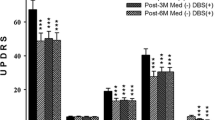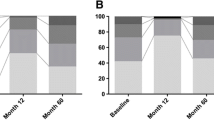Abstract
Background
Subthalamic Nucleus Deep Brain Stimulation (STN-DBS) has been shown to significantly improve motor symptoms in advanced Parkinson’s disease (PD). Only few studies, however, have focused on the non-motor effects of DBS.
Methods
A consecutive series of 15 patients was assessed three months before (M-3), then three months (M3) and six months (M6) after surgery. Mean (± SD) age at surgery was 59.7 (7.6). Mean disease duration at surgery was 12.2 (2.8) years. The Mini International Neuropsychiatric Inventory was used to assess psychiatric disorders three months before surgery. Depression was evaluated using Montgomery and Asberg Rating Scale (MADRS). Anxiety was evaluated using the AMDP system (Association for Methodology and Documentation in Psychiatry). Apathy was particularly evaluated using the Apathy Evaluation Scale (AES) and the Starkstein Scale. All these scales were performed at every evaluation.
Results
Apathy worsened at M3 and M6 after STN-DBS in comparison with the preoperative evaluation: the AES mean score was significantly impaired between the preoperative (38.4±7.1) and both the postoperative M3 (44.6±9.5, p = 0.003) and M6 scores (46.0±10.9, p = 0.013). Significant worsening of apathy was confirmed using the Starkstein scale. There was no evidence of depression: the mean MADRS score did not differ before surgery (9.1±7.4) and at both M3 (8.6±8.2) and M6 (9.9±7.7) after STN-DBS. The anxiety level did not change between preoperative (9.4±9.2) and both M3 (5.5±4.5) and M6 (6.6±4.6) postoperative states.
Conclusion
Although STN-DBS constitutes a therapeutic advance for severely disabled patients with Parkinson’s disease, we should keep in mind that this surgical procedure may contribute to the inducing of apathy. Our observation raises the issue of the direct influence of STN- DBS on the limbic system by diffusion of stimulus to the medial limbic compartment of STN.
Similar content being viewed by others
References
Aarsland D, Larsen JP, Lim NG, Janvin C, Karlsen K, Tandberg E, Cummings JL (1999) Range of neuropsychiatric disturbances in patients with Parkinson’s disease. J Neurol Neurosurg Psychiatry 67:492–496
Ardouin C, Pillon B, Peiffer E, Bejjani P, Limousin P, Damier P, Arnulf I, Benabid AL, Agid Y, Pollak P (1999) Bilateral subthalamic or pallidal stimulation for Parkinson’s disease affects neither memory nor executive functions: a consecutive series of 62 patients. Ann Neurol 46:217–223
Benabid AL, Krack PP, Benazzouz A, Limousin P, Koudsie A, Pollak P (2000) Deep brain stimulation of the subthalamic nucleus for Parkinson’s disease: methodologic aspects and clinical criteria. Neurology 55:S40–44
Berney A, Vingerhoets F, Perrin A, Guex P, Villemure JG, Burkhard PR, Benkelfat C, Ghika J (2002) Effect on mood of subthalamic DBS for Parkinson’s disease: a consecutive series of 24 patients. Neurology 59:1427–1429
Biseul I, Sauleau P, Haegelen C, Trebon P, Drapier D, Raoul S, Drapier S, Lallement F, Rivier I, Lajat Y, Verin M (2005) Fear recognition is impaired by subthalamic nucleus stimulation in Parkinson’s disease Neuropsychologia 43:1054–1059
Bobon D (1985) [Contribution of the AMDP scale to quantitative psychopathology] Acta Psychiatr Belg 85:5–249
Cardebat D, Doyon B, Puel M, Goulet P, Joanette Y (1990) [Formal and semantic lexical evocation in normal subjects. Performance and dynamics of production as a function of sex, age and educational level]. Acta Neurol Belg 90:207–217
Czernecki V, Pillon B, Houeto JL, Welter ML, Mesnage V, Agid Y, Dubois B (2005) Does bilateral stimulation of the subthalamic nucleus aggravate apathy in Parkinson’s disease? J Neurol Neurosurg Psychiatry 76:775–779
Doshi P, Chhaya N, Bhatt M (2002) Depression leading to attempted suicide after bilateral subthalamic nucleus stimulation for Parkinson’s disease. Mov Disod 17:1084–1085
Drapier S, Raoul S, Drapier D, Leray E, Lallement F, Rivier I, Sauleau P, Lajat Y, Edan G, Verin M (2005) Only physical aspects of quality of life are significantly improved by bilateral subthalamic stimulation in Parkinson’s disease. J Neurol 252:583–588
Fahn S, Elton R (1987) UPDRS Development committee. Unified Parkinson’s disease Rating Scale. Recent development in Parkinson’s disease. Vol 2:153–163
Funkiewiez A, Ardouin C, Caputo E, Krack P, Fraix V, Klinger H, Chabardes S, Foote K, Benabid AL, Pollak P (2004) Long term effects of bilateral subthalamic nucleus stimulation on cognitive function, mood, and behaviour in Parkinson’s disease. J Neurol Neurosurg Psychiatry 75:834–839
Funkiewiez A, Ardouin C, Krack P, Fraix V, Van Blercom N, Xie J, Moro E, Benabid AL, Pollak P (2003) Acute psychotropic effects of bilateral subthalamic nucleus stimulation and levodopa in Parkinson’s disease. Mov Disord 18:524–530
Herzog J, Reiff J, Krack P, Witt K, Schrader B, Muller D, Deuschl G (2003) Manic episode with psychotic symptoms induced by subthalamic nucleus stimulation in a patient with Parkinson’s disease. Mov Disord 18:1382–1384
Hoehn N, Yahr M (1967) Parkinsonism: onset, progression and normality. Neurology 17:427–442
Houeto JL, Mesnage V, Mallet L, Pillon B, Gargiulo M, du Moncel ST, Bonnet AM, Pidoux B, Dormont D, Cornu P, Agid Y (2002) Behavioural disorders, Parkinson’s disease and subthalamic stimulation. J Neurol Neurosurg Psychiatry 72:701–707
Isella V, Melzi P, Grimaldi M, Iurlaro S, Piolti R, Ferrarese C, Frattola L, Appollonio I (2002) Clinical, neuropsychological, and morphometric correlates of apathy in Parkinson’s disease. Mov Disord 17:366–371
Krack P, Kumar R, Ardouin C, Dowsey PL, McVicker JM, Benabid AL, Pollak P (2001) Mirthful laughter induced by subthalamic nucleus stimulation. Mov Disord 16:867–875
Krack P, Pollak P, Limousin P, Hoffmann D, Xie J, Benazzouz A, Benabid AL (1998) Subthalamic nucleus or internal pallidal stimulation in young onset Parkinson’s disease. Brain 121(Pt 3):451–457
Kulisevsky J, Berthier ML, Gironell A, Pascual-Sedano B, Molet J, Pares P (2002) Mania following deep brain stimulation for Parkinson’s disease. Neurology 59:1421–1424
Langston JW, Widner H, Goetz CG, Brooks D, Fahn S, Freeman T, Watts R (1992) Core assessment program for intracerebral transplantations (CAPIT). Mov Disord 7:2–13
Levy ML, Cummings JL, Fairbanks LA, Masterman D, Miller BL, Craig AH, Paulsen JS, Litvan I (1998) Apathy is not depression J Neuropsychiatry. Clin Neurosci 10:314–319
Limousin P, Krack P, Pollak P, Benazzouz A, Ardouin C, Hoffmann D, Benabid AL (1998) Electrical stimulation of the subthalamic nucleus in advanced Parkinson’s disease. N Engl J Med 339:1105–1111
Lozano AM, Lang AE, Galvez-Jimenez N, Miyasaki J, Duff J, Hutchinson WD, Dostrovsky JO (1995) Effect of GPi pallidotomy on motor function in Parkinson’s disease. Lancet 346:1383–1387
Marin RS (1991) Apathy: a neuropsychiatric syndrome. J Neuropsychiatry Clin Neurosci 3:243–254
Marin RS (1990) Differential diagnosis and classification of apathy. Am J Psychiatry 147:22–30
Marin RS, Biedrzycki RC, Firinciogullari S (1991) Reliability and validity of the Apathy Evaluation Scale. Psychiatry Res 38:143–162
Marin RS, Firinciogullari S, Biedrzycki RC (1993) The sources of convergence between measures of apathy and depression. J Affect Disord 28:117–124
Mattis S (1988) Dementia rating scale. Psychological Assessment
Middleton FA, Strick PL (2000) Basal ganglia and cerebellar loops: motor and cognitive circuits. Brain Res Brain Res Rev 31:236–250
Montgomery SA, Asberg M (1979) A new depression scale designed to be sensitive to change. Br J Psychiatry 134:382–389
Nelson HE (1976) A modified card sorting test sensitive to frontal lobe defects. Cortex 12:313–324
Parent A, Hazrati LN (1995) Functional anatomy of the basal ganglia. I. The cortico-basal ganglia-thalamo-cortical loop. Brain Res Brain Res Rev 20:91–127
Pluck GC, Brown RG (2002) Apathy in Parkinson’s disease. J Neurol Neurosurg Psychiatry 73:636–642
Reitan RM (1958) Validity of the trail making test as an indication of organic brain damage Percept Motor Skill 8:271–276
Romito LM, Raja M, Daniele A, Contarino MF, Bentivoglio AR, Barbier A, Scerrati M, Albanese A (2002) Transient mania with hypersexuality after surgery for high frequency stimulation of the subthalamic nucleus in Parkinson’s disease. Mov Disord 17:1371–1374
Saint-Cyr JA, Trepanier LL, Kumar R, Lozano AM, Lang AE (2000) Neuropsychological consequences of chronic bilateral stimulation of the subthalamic nucleus in Parkinson’s disease. Brain 123(Pt 10):2091–2108
Sauleau P, Raoul S, Lallement F, Rivier I, Drapier S, Lajat Y, Verin M (2005) Motor and non motor effects during intraoperative subthalamic stimulation for Parkinson’s disease. J Neurol 252:457–464
Sheehan DV, Lecrubier Y, Sheehan KH, Amorim P, Janavs J, Weiller E, Hergueta T, Baker R, Dunbar GC (1998) The Mini-International Neuropsychiatric Interview (M.I.N.I.): the development and validation of a structured diagnostic psychiatric interview for DSM-IV and ICD-10. J Clin Psychiatry 59 Suppl 20:22–33; quiz 34–57
Starkstein SE, Ingram L, Garau ML, Mizrahi R (2005) On the overlap between apathy and depression in dementia. J Neurol Neurosurg Psychiatry 76:1070–1074
Starkstein SE, Mayberg HS, Preziosi TJ, Andrezejewski P, Leiguarda R, Robinson RG (1992) Reliability, validity, and clinical correlates of apathy in Parkinson’s disease. J Neuropsychiatry Clin Neurosci 4:134–139
Stroop JR (1935) Studies of interference in serial verbal reactions. J Exp Psych 18:643–662
Trepanier LL, Kumar R, Lozano AM, Lang AE, Saint-Cyr JA (2000) Neuropsychological outcome of GPi pallidotomy and GPi or STN deep brain stimulation in Parkinson’s disease. Brain Cogn 42:324–347
Van Horn G, Schiess MC, Soukup VM (2001) Subthalamic deep brain stimulation: neurobehavioral concerns. Arch Neurol 58:1205–1206
Volkmann J, Allert N, Voges J, Weiss PH, Freund HJ, Sturm V (2001) Safety and efficacy of pallidal or subthalamic nucleus stimulation in advanced PD. Neurology 56:548–551
Welter ML, Houeto JL, Tezenas du Montcel S, Mesnage V, Bonnet AM, Pillon B, Arnulf I, Pidoux B, Dormont D, Cornu P, Agid Y (2002) Clinical predictive factors of subthalamic stimulation in Parkinson’s disease. Brain 125:575–583
Acknowledgements
The authors thank Philip ROUSSEAU-CUNNINGHAM for preparing the manuscript
Author information
Authors and Affiliations
Corresponding author
Rights and permissions
About this article
Cite this article
Drapier, D., Drapier, S., Sauleau, P. et al. Does subthalamic nucleus stimulation induce apathy in Parkinson’s disease?. J Neurol 253, 1083–1091 (2006). https://doi.org/10.1007/s00415-006-0177-0
Received:
Revised:
Accepted:
Published:
Issue Date:
DOI: https://doi.org/10.1007/s00415-006-0177-0




